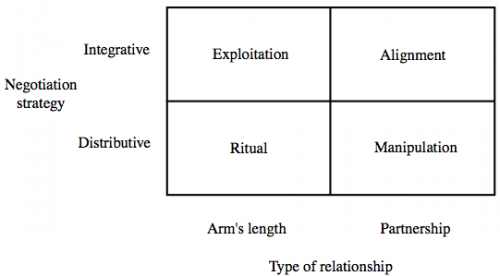Negotiation Strategies in Supply Chain Management
Within a supply chain many supplier-buyer relationships exist. Even though supply chain management aims to take a high level view, these dyadic relationships form the basis of the supply chain and therefore should be the focus of a supply chain analysis.
The negotiation of the terms of these relationships defines the structure of the supply chain and can affect the power and profit distribution within the supply chain itself.
So, this week we’ll have a closer look at negotiations in the supply chain using a 2008 paper by Frederik Zachariassen.
Method
As usual the work starts with an overview on negotiation-related literature in supply chain management and more general cases. The author finds several sources dealing with supply chain related negotiations, but notes:
The amount of negotiation literature dealing with negotiation strategies in a [general] commercial, business relationship is sparse and lacking in empirical research as stated in the introduction.
Due to these conclusions the core method is set to a case study to analyze the negotiating strategies on a general, qualitative level.
Overall 25 interview- and 15 observation-hours were conducted with a focal company and their suppliers. All results have been anonymized and “the total hours of interviews were split up between interviewing purchasing personnel on site of the case company and interviewing suppliers that interacted closely with the case company”.
Two universal negotiation types emerge:
The distributive negotiation strategy is used by those negotiators, who believe that they and their counterpart have fundamentally opposed interests. As a result, negotiators believe that negotiations essentially can be described as win-lose situations, in which one should try to argue as aggressively and intensively as possible in order to convince the other party of price reductions, reduced delivery time, etc. In negotiation literature, it has been paralleled to one-off relationships, e.g. arm’s length relationships.
On the contrary, the integrative approach seeks to reconcile the parties’ divergent interests and provide both parties with joint benefits as an outcome of the specific negotiation. This approach emphasises the need for trust, mutual understanding, openness and a sense for empathy. As such, the integrative approach attempts to capture synergistic advantages in the form of mutual gains, and therefore believes in win-win relationships.
Results
Figure 1 shows the resulting framework to structure different supplier-buyer-relationships and the corresponding negotiation strategy. Overall four cases can be distinguished.
Figure 1: Relationship Type vs. Negotiation Strategy Matrix (Zachariassen, 2008)
In the ritual case a arms-length relationship is met with a distributive/competitive negotiation approach.
As an arm’s length relationship has relatively low-switching costs compared to the more strategic partnership, both parties expressed an indifference towards the other party when considering the outcome of the negotiation. That is, should the counterpart in the negotiations demand a too unrealisable price when compared with the market price, the negotiator would simply exit the negotiation and contact other suppliers/buyers. […] Here, buyers and suppliers would often manipulate numbers and statistics by presenting them in Excel spreadsheets that were at best confusing for the counterpart, only to be briefly presented in the negotiation setting. Graphs of for instance the recent price development of a standard good would often be manipulated, so that curves would be represented as flatter or steeper depending on the point, buyers or suppliers wanted to make.
In a exploitation setting greater integration is sought in a arms-length-relationship setting. This combination is seen very critical:
Buyers and suppliers remarked that taking the chance of being completely open and trusting towards the other party would be too high considering the risk of the other party exploiting the other party. One supplier remarked that that would at best be naive and would be inexpedient insofar as negotiating the best deal for their respective firms.
For the partnership approach the manipulation category represents the case where companies used more subtile techniques to enforce their competitive pricing ideas, example:
The buyers resided in a larger and more powerful firm that all things being equal had more negotiation power than the suppliers. During the participant observations of strategic partnership negotiations, it quickly became apparent that the buyers opted for a distributive negotiation strategy. It differed, however, from the arm’s length relationship one by employing more subtle, rhetorical devices in order to argue towards the suppliers that prices should go down. The subtlety lied in the buyers’ sophisticated approach to bargaining.
Lastly, in a partnership relationship a more integrative approach could be used, leading to a alignment categorization:
This was characterised as a more of a hypothetical situation by buyers and suppliers. That is, both would not opt for this approach when considering strategic partnerships. […] both buyers and suppliers would express concern regarding the disclosure of strategically relevant information, loss of power and loss of control in strategic partnerships due to a too open approach to negotiating and cooperating.
Conclusion
In this study the author analyzed two distinct negotiation approaches in supply chain management within two separate relationship settings.
Core implication of this practice-view on this questions is that neither in a arms-length nor in a partnership relationship, the strategic partnership negotiation strategies are considered as an viable option.
Of course, this is a quite interesting finding, which I would have loved to see questioned by the author a little bit more.
There are definitely case studies proving that a close and integrative relationship can work and on the other hand SCM literature often complains the lack of strategic integration on the supply chain but also the individual level.
So the real question is: what are the core drivers to an integrative negotiation approach and what are the external factors influencing this decision?
Zachariassen, F. (2008). Negotiation strategies in supply chain management International Journal of Physical Distribution & Logistics Management, 38 (10), 764-781 DOI: 10.1108/09600030810926484









Add new comment